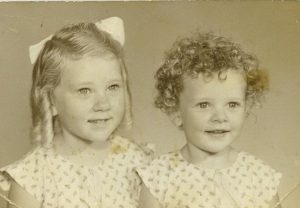The prompt for this week is “challenge”. Well, how to pick just one challenge is a bit of a challenge. To me, genealogy is an ongoing challenge in which we use our detective skills to ferret out as much information as possible about our ancestors and families. Considering it’s the start of the year, I thought I would share one of my earlier challenges.
When I first got serious about doing my family history, I wrote down what I knew about my immediate family. I knew without asking the names of my grandmother’s but needed some help form my parents on the names of my grandfathers, as they had both passed before I was able to know them. I always knew that my mum had essentially grown up without a father, and so she didn’t know a lot at all about him. She knew his name and we had managed to find a few photos after my grandmother’s death but that was it. So the challenge was to find out ore about him.

My grandfather George as a young child
I went to the courthouse and asked how I would go about applying for the birth certificates of my parents, and was promptly told that I would be better off ordering marriage certificates as they were free access after 50 years whereas broths had a 100 year limit on them. So I left the courthouse with the necessary forms to order the marriage certificate of my grandparents and I promptly went home and started searching online for the necessary information. This was when I hit my first snag: my search for a George Nichols marrying a Jean Thompson returned no results.
Perplexed, I approached my mum and said I couldn’t find her parents marriage certificate. We both scratched our heads over it for a while, until we remembered that my grandmother had been married before so would have been married under her first husband’s surname. So off I went again armed with the correct surname this time and after a bit of fiddling with spelling, I hit gold. Once I received the certificate I had an approximate birth date for him and a mother’s name. But no father’s name, which is an ongoing challenge of mine to find out who his father was.


Being new to family history, I was so excited to have found the information and I distinctly recall being asked a few years later about my family history and excitedly sharing the news that I was now able to order my grandfather’s birth certificate as the 100 year time limit had passed (it being 2010 at the time). To my disappointment, the person scoffed at me stating it was “impossible” that my grandfather had been born in 1910 considering my mother was born in 1961. However, I know the truth of my findings.
So that’s my challenge post, but the challenge of finding out my grandfathers father is ongoing as is challenging people’s perceptions about family history in general and on a more personal level. But I admit to enjoying a challenge and will continue forward with my passion.





 This is one of the first photos that became part of my collection, and I remember asking my mother about it and she can remember getting ready the night before the picture was taken. She can’t remember exactly how old she was, but she does remember the photo being taken and that it was before her parents marriage broke up. My mother was lucky enough that she had natural curls, so her preparation was pretty basic. However, she remembers her sister Jayne as having have her hair done up in rags so that she would have beautiful curls for the photo. The two girls are dressed in identical dresses which were handmade by my grandmother, as nearly all of their clothes were.
This is one of the first photos that became part of my collection, and I remember asking my mother about it and she can remember getting ready the night before the picture was taken. She can’t remember exactly how old she was, but she does remember the photo being taken and that it was before her parents marriage broke up. My mother was lucky enough that she had natural curls, so her preparation was pretty basic. However, she remembers her sister Jayne as having have her hair done up in rags so that she would have beautiful curls for the photo. The two girls are dressed in identical dresses which were handmade by my grandmother, as nearly all of their clothes were.
 I can remember asking my grandmother who the child in the photos was and her replying that it was her as a little girl. to me, who was only young at the time (maybe 8 or 9 years old) this was amazing. Over the years, I can remember her telling stories about her growing up years and haring stories from my mother who had heard them from her grandmother. When my grandmother died, my mum and I decided to do some investigating into my grandmothers family and we found something quite quickly on the first ancestor of hers to come to Australia: a convict. And with that, my family history journey was started.
I can remember asking my grandmother who the child in the photos was and her replying that it was her as a little girl. to me, who was only young at the time (maybe 8 or 9 years old) this was amazing. Over the years, I can remember her telling stories about her growing up years and haring stories from my mother who had heard them from her grandmother. When my grandmother died, my mum and I decided to do some investigating into my grandmothers family and we found something quite quickly on the first ancestor of hers to come to Australia: a convict. And with that, my family history journey was started.